I am replicating them as I had a pair of 3 in TB's at hand.
In my case it would be fairly cheap as I purchased a pair of 7 in 88 db, 0.6 Qts, ~40-45 Hz Fs midbass drivers for $30
Here is the design work so far in pictures.
As I read the simulations, it should be possible to get away with 1-st order crossover and even no BSC.
Here is the object of replication interest: LXmini Challenge an active system that is quasi omnidirectional and illuminating the space with sound in an faithful and life like manner.
As the main virtue of the system is it's acoustical constellation, the replica should be able to achieve the original's performance to a satisfactory extent without it's complexity and high price.
I had a little thought on the LX-Mini article and came to some pretty interesting conclusions.
In the description it is stated that the pipe with the fiber fill is intended for reducing the emission of high frequencies in that direction and to obtain a cardioid circle diagram which aids placing the speakers near the boundaries of the acoustic environment.
I would believe that if I wasn't sure that He addresses only the frequencies between the crossover frequency and the low cut off frequency of the baffle which in the specific case is about 2 kHz. And which are those frequencies emitted from and around the magnet? Wink, here at help comes an MJK's publication where he regards the openings in the chassis as a transmission lines and having in mind that the directivity comes with frequency, then definitely the only frequencies which have vector through the pipe are those from the first two octaves above the crossover frequency 700-1400-2800 Hertz. The rest is anyway emitted at vectors defined by the openings and the surface of the membrane, or in other words sideways.
Therefore, the drivers with non vented magnet system either way emit more and more cardioidally towards the high frequencies.
I think that uncle Siegfried Linkwitz has put the pipe there in order to reduce the size of the required baffle to the size of the chassis, but due to the fact that he measures circle diagram, he saw that the cardioidal character of the emission is underlined.
I am even ready to bet on that the wadding in the pipe in not there to absorb sound in the high frequencies, but to reduce pipe resonance in lower frequencies!
For the cardioid emission in the high frequencies it is enough that such a cylindrical body is present in that place.
Parameters of the midbass drivers:
50W
Qms : 2,54
Qes : 0,94
Qt : 0,68
Vas : 27-45 L
Fs ~38-45 Hz
40 - 5000 Hz
88 dB
Thay are insignificant to you as they are from local manufacturer and as far as I know are not exported. The Qts of 0.5 and above gives the opportunity to tune Fb of an eventual vented system lower than the driver Fs. In the present case a not so big ~30L vented box would allow pretty decent F3@40Hz with reduced fill there would even be a bump in low the response which I find pleasant to listen to.
Now a simple for understanding pictures follow.
The Bass box simulation takes into account enclosure face plate dimensions and vent size, but does not account for beaming.
N.B. The first label in Bulgarian on the simulation picture is regarding the box which is for a local driver, thus not important;
The second is a screenshot from The Edge - self explanatory;
And the third text is that the level of the mid/HF is higher than the one of the woofer. The rising response of the woofer is not a problem even if it resides after simple crossover, because of the 360 propagation pattern thus the falling response perceived at any single point in surrounding space.
Bulgarian language thread: http://penkiller.com/index.php/topic,1167.0.html (pointing here as well)
In my case it would be fairly cheap as I purchased a pair of 7 in 88 db, 0.6 Qts, ~40-45 Hz Fs midbass drivers for $30
Here is the design work so far in pictures.
As I read the simulations, it should be possible to get away with 1-st order crossover and even no BSC.
Here is the object of replication interest: LXmini Challenge an active system that is quasi omnidirectional and illuminating the space with sound in an faithful and life like manner.
As the main virtue of the system is it's acoustical constellation, the replica should be able to achieve the original's performance to a satisfactory extent without it's complexity and high price.
I had a little thought on the LX-Mini article and came to some pretty interesting conclusions.
In the description it is stated that the pipe with the fiber fill is intended for reducing the emission of high frequencies in that direction and to obtain a cardioid circle diagram which aids placing the speakers near the boundaries of the acoustic environment.
I would believe that if I wasn't sure that He addresses only the frequencies between the crossover frequency and the low cut off frequency of the baffle which in the specific case is about 2 kHz. And which are those frequencies emitted from and around the magnet? Wink, here at help comes an MJK's publication where he regards the openings in the chassis as a transmission lines and having in mind that the directivity comes with frequency, then definitely the only frequencies which have vector through the pipe are those from the first two octaves above the crossover frequency 700-1400-2800 Hertz. The rest is anyway emitted at vectors defined by the openings and the surface of the membrane, or in other words sideways.
Therefore, the drivers with non vented magnet system either way emit more and more cardioidally towards the high frequencies.
I think that uncle Siegfried Linkwitz has put the pipe there in order to reduce the size of the required baffle to the size of the chassis, but due to the fact that he measures circle diagram, he saw that the cardioidal character of the emission is underlined.
I am even ready to bet on that the wadding in the pipe in not there to absorb sound in the high frequencies, but to reduce pipe resonance in lower frequencies!
For the cardioid emission in the high frequencies it is enough that such a cylindrical body is present in that place.
Parameters of the midbass drivers:
50W
Qms : 2,54
Qes : 0,94
Qt : 0,68
Vas : 27-45 L
Fs ~38-45 Hz
40 - 5000 Hz
88 dB
Thay are insignificant to you as they are from local manufacturer and as far as I know are not exported. The Qts of 0.5 and above gives the opportunity to tune Fb of an eventual vented system lower than the driver Fs. In the present case a not so big ~30L vented box would allow pretty decent F3@40Hz with reduced fill there would even be a bump in low the response which I find pleasant to listen to.
Now a simple for understanding pictures follow.
The Bass box simulation takes into account enclosure face plate dimensions and vent size, but does not account for beaming.
N.B. The first label in Bulgarian on the simulation picture is regarding the box which is for a local driver, thus not important;
The second is a screenshot from The Edge - self explanatory;
And the third text is that the level of the mid/HF is higher than the one of the woofer. The rising response of the woofer is not a problem even if it resides after simple crossover, because of the 360 propagation pattern thus the falling response perceived at any single point in surrounding space.
Bulgarian language thread: http://penkiller.com/index.php/topic,1167.0.html (pointing here as well)
Attachments
-
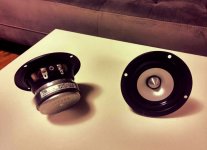 1412112770354-1.jpg71.3 KB · Views: 1,878
1412112770354-1.jpg71.3 KB · Views: 1,878 -
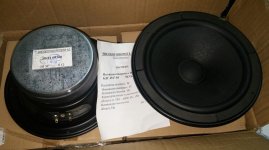 20141031_195902-1.jpg80.5 KB · Views: 1,855
20141031_195902-1.jpg80.5 KB · Views: 1,855 -
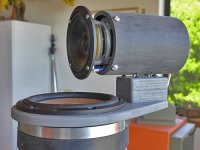 transducer-mounting-1.jpg29.7 KB · Views: 1,868
transducer-mounting-1.jpg29.7 KB · Views: 1,868 -
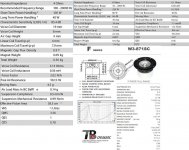 H1600-04-specs.jpg168.7 KB · Views: 1,840
H1600-04-specs.jpg168.7 KB · Views: 1,840 -
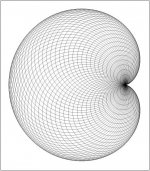 561px-CardioidCircleEnvelope.jpg104.2 KB · Views: 1,830
561px-CardioidCircleEnvelope.jpg104.2 KB · Views: 1,830 -
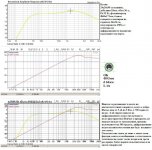 LXminiReplicaPassive.jpg120.4 KB · Views: 414
LXminiReplicaPassive.jpg120.4 KB · Views: 414 -
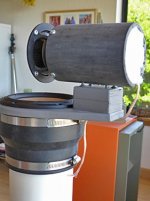 transducer-mounting-2.jpg19.3 KB · Views: 496
transducer-mounting-2.jpg19.3 KB · Views: 496
Last edited:
Awesome stuff!
However, are you keeping this in mind?
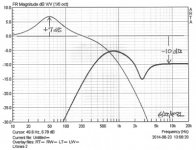
...
I think that uncle Siegfried Linkwitz has put the pipe there in order to reduce the size of the required baffle to the size of the chassis, but due to the fact that he measures circle diagram, he saw that the cardioidal character of the emission is underlined.
I am even ready to bet on that the wadding in the pipe in not there to absorb sound in the high frequencies, but to reduce pipe resonance in lower frequencies!...
However, are you keeping this in mind?

Last edited:
I know the article by heart.
This is a graph of the DSP equalization applied.
The midbass enclosure of the original is undersized for no reason as a two-three times the volume would have comparable footprint.
So the 7db Eq is not needed in a decently sized vented cabinet with 7 in driver.
Further the full range has more sensitivity and operates in the diffraction plato -> +6 db due to 1/2 phi operation.
I think that the whole active system and EQ-ing is there just because this is SL - the king of DSP, ASP, crossovers and etc. and the drivers have to be Seas.
And the whole thing is sold to the public as a driver in a what looks like a sewer pipe, but the actual system is not cheap at all while exploiting very simple phenomenons.
Actually it is obvious that a relatively flat system exhibiting the same acoustic features can be constructed with just a first order crossover.
If you ask me, the most interesting is how someone like Siegfried Linkwitz has to put a bare 3 inch driver in space and tell people that sounds good! Every single member of the forum has heard the beauty of the sound of a bare driver, and very few designed anything exploiting that.
This is a graph of the DSP equalization applied.
The midbass enclosure of the original is undersized for no reason as a two-three times the volume would have comparable footprint.
So the 7db Eq is not needed in a decently sized vented cabinet with 7 in driver.
Further the full range has more sensitivity and operates in the diffraction plato -> +6 db due to 1/2 phi operation.
I think that the whole active system and EQ-ing is there just because this is SL - the king of DSP, ASP, crossovers and etc. and the drivers have to be Seas.
And the whole thing is sold to the public as a driver in a what looks like a sewer pipe, but the actual system is not cheap at all while exploiting very simple phenomenons.
Actually it is obvious that a relatively flat system exhibiting the same acoustic features can be constructed with just a first order crossover.
If you ask me, the most interesting is how someone like Siegfried Linkwitz has to put a bare 3 inch driver in space and tell people that sounds good! Every single member of the forum has heard the beauty of the sound of a bare driver, and very few designed anything exploiting that.
Last edited:
I know the article by heart.
This is a graph of the DSP equalization applied.
No, actually it's not. That's a general EQ plot for public consumption, but the actual LXmini EQ curves are quite a bit more complex......especially the tweeter driver. (Something that can only be implemented with a DSP solution.)
Dave.
I will second that. It really is substantially different to the EQ plot. This cannot be replicated with a passive crossover.
That's not to say you cannot make a pleasant enough sounding passive speaker.
I am thinking of designing a LXMini clone spkrs in the same vein as you, currently I have already a pair of LXMini clone using MiniDSP. I was able to get reasonably flat response from full ranger without using equalization from the MiniDSP, then the only area which I need to overcome is the lower end which I must avoid using Linkwitz transformed equalization. If that is the case then I need to build a transmission line cabinet to house the woofer. Overall no need to use active filter e.g. MiniDSP just plain passive components. Just my thoughts.
Or you could build the actual LXmini to SL's design...nahhh, why bother when you can reinvent the wheel even better!
Besause it is about 1000$, it has got allot of boxes and wires and woyld not play out of my vintage Pioneer because without it's boxes and wires it is just a couple of low sensitivity Seas drivers with unpleadant frequency response.
And most importnt, it is not a wheel! ;-)
SL is a genius, thus the LX-Mini is simple to replicate!
Last edited:
I am thinking of designing a LXMini clone spkrs in the same vein as you, currently I have already a pair of LXMini clone using MiniDSP. I was able to get reasonably flat response from full ranger without using equalization from the MiniDSP, then the only area which I need to overcome is the lower end which I must avoid using Linkwitz transformed equalization. If that is the case then I need to build a transmission line cabinet to house the woofer. Overall no need to use active filter e.g. MiniDSP just plain passive components. Just my thoughts.
I built LX Mini, not a clone.
I built LX Mini, not a clone.
I didn't build a clone or the mini, nor the pluto just over a year ago. I suppose it could have been called the LX Maxi, if Sig designed it. Maxi is appropriate as it used two 6.5" midbasses in a mltl. Nothing remotely whimpy about it as the usable lowend of 26Hz left very little to miss. Used a minidsp for control.
That speaker was built to act as a test bed to relearn a few things I may have forgotten, or was never aware of in the 2 decades I wasnt building. More of a mental challenge, easily replicated.
With that said, bring it on DIY!
I just finished the actual LXMini, but I already had the amp from a previous experiment with 3-channel ala Meridian, and I already had an unbuilt Pluto, so I had the woofers. I'd recommend them to anyone.
If you can "clone" them for cheap, you'd have something to brag about. On the other hand ...
If you can "clone" them for cheap, you'd have something to brag about. On the other hand ...
I would have finished them by now, but there were no shelfs at the hardware store. I want to build them in one hour in the kitchen, so I decided to make the bass cabinet from off the shelf shelfs glued with moment glue. If there were laminated in different colors, I would make an Harlequin speakers - green, red, blue, yellow etc. depending on the available.
In my recent pipe and fiber wadding experience: http://www.diyaudio.com/forums/full-range/265107-very-fast-speaker.html my theory that the pipe is doing there and what the fiber fill is doing in the pipe just got confirmed.
rob g, tubesguy, would you share some experience? What is the sound like, does it confirm the claims of SL?
What is it like without the fill in the pipe?
And what is the diameter of the pipe?
I will do it with 80 mm pipe which I already purchased. I got a 100 mm pipe as well, but it is too big and went to the experiment with the 5 minute morning speaker.
In my recent pipe and fiber wadding experience: http://www.diyaudio.com/forums/full-range/265107-very-fast-speaker.html my theory that the pipe is doing there and what the fiber fill is doing in the pipe just got confirmed.
rob g, tubesguy, would you share some experience? What is the sound like, does it confirm the claims of SL?
What is it like without the fill in the pipe?
And what is the diameter of the pipe?
I will do it with 80 mm pipe which I already purchased. I got a 100 mm pipe as well, but it is too big and went to the experiment with the 5 minute morning speaker.
I didn't build a clone or the mini, nor the pluto just over a year ago. I suppose it could have been called the LX Maxi, if Sig designed it. Maxi is appropriate as it used two 6.5" midbasses in a mltl. Nothing remotely whimpy about it as the usable lowend of 26Hz left very little to miss. Used a minidsp for control
It's a mini compared to the LX521 which is what Linkwitz is comparing it to. That thing is a beast!
True.
The point was the design Sig has made popular is not new nor a difficult concept to grasp. Juhazi suggested me to build mine out. Not a bad idea if it weren't for another design I was (and still am) working on. Only built this to have something to listen to in the mean time, and to get a ear on what the measurements show. My goals are also very different. > 95% either cannot or do not place speakers >2+ feet away from the front wall, whereas I'm working only on a nearwall placement design, that if you want can be placed out into a room.
The point was the design Sig has made popular is not new nor a difficult concept to grasp. Juhazi suggested me to build mine out. Not a bad idea if it weren't for another design I was (and still am) working on. Only built this to have something to listen to in the mean time, and to get a ear on what the measurements show. My goals are also very different. > 95% either cannot or do not place speakers >2+ feet away from the front wall, whereas I'm working only on a nearwall placement design, that if you want can be placed out into a room.
Has anyone considered an extra-frugal version of the speaker? While I am unlikely to do this I think someone else should 
Proposed: foam core or similar enclosure (with BBC/Harwood ideas to use thin wall and damping to lower cabinet resonances); cheap drivers (this probably rules out Seas quality) -- any subs available? And for EQ and Amp, cheap cheap cheap. Here is my nomination: while I am a fan of MiniDSP, I defy you to find a DSP and amp solution cheaper than a "New Old Stock" Sherwood Newcastle R-772 (R-771 appears similar) at around $200 delivered. This is a 7.1 HTS receiver with 100 watts/channel into 8 ohms. Also has a 7-band semi-PEQ per channel that -- probably -- could meet crossover needs. I did in fact buy the R-772 a few years ago for two gift systems to friends driving Bose 901s and the results were -- ok at least. (I EQ-ed using REW sweeps). As far as I can tell, the R-772 is no longer available; the R-771 appears to be the same except HDMI for video is not included. There are limitations, not the least is the complex interface (TV screen and remote needed) to set stuff up. Also, the amp sections don't want less than 6 ohms if I recall.
Proposed: foam core or similar enclosure (with BBC/Harwood ideas to use thin wall and damping to lower cabinet resonances); cheap drivers (this probably rules out Seas quality) -- any subs available? And for EQ and Amp, cheap cheap cheap. Here is my nomination: while I am a fan of MiniDSP, I defy you to find a DSP and amp solution cheaper than a "New Old Stock" Sherwood Newcastle R-772 (R-771 appears similar) at around $200 delivered. This is a 7.1 HTS receiver with 100 watts/channel into 8 ohms. Also has a 7-band semi-PEQ per channel that -- probably -- could meet crossover needs. I did in fact buy the R-772 a few years ago for two gift systems to friends driving Bose 901s and the results were -- ok at least. (I EQ-ed using REW sweeps). As far as I can tell, the R-772 is no longer available; the R-771 appears to be the same except HDMI for video is not included. There are limitations, not the least is the complex interface (TV screen and remote needed) to set stuff up. Also, the amp sections don't want less than 6 ohms if I recall.
An interesting "hack" in fact, using a R-772 or similar is this: how many channels are independently driven? I know the R-772 has two room capability, as well as to bi-amp a stereo pair. So you effectively have a MiniDSP 2x4 with 100 w/ch amps (downside is the limited PEQ settings); possibly as much as 2 in, 6 out maybe? Might closeout Home theater receivers be an overlooked active speaker and EQ-ing option?
I was like, "Damn I'm going to build this!" then I noticed it uses the MiniDSP piece of ****. I'm not going backwards on the quality of my DAC with one of those farts.
The only "cheap" option maybe would be two Crown XLS using active crossover with their link feature. However I don't prefer the amp.
I'm very interested in a passive version of the speaker. The amount of refinement offered 24/db crossover has as much to do with many amplifiers inability to drive a crossover well as anything else I'm sure.
I've considered just building my XL-S Encores into this configuration since a large pipe ported would be the same as a box, the tweeter has a built in enclosure, and they sound good in "omni" configuration anyways. Although maybe I should just build boxes... It's really the tweeter mounted over the midwoofer that's so different, yes?
The only "cheap" option maybe would be two Crown XLS using active crossover with their link feature. However I don't prefer the amp.
I'm very interested in a passive version of the speaker. The amount of refinement offered 24/db crossover has as much to do with many amplifiers inability to drive a crossover well as anything else I'm sure.
I've considered just building my XL-S Encores into this configuration since a large pipe ported would be the same as a box, the tweeter has a built in enclosure, and they sound good in "omni" configuration anyways. Although maybe I should just build boxes... It's really the tweeter mounted over the midwoofer that's so different, yes?
I was like, "Damn I'm going to build this!" then I noticed it uses the MiniDSP piece of ****. I'm not going backwards on the quality of my DAC with one of those farts.
The only "cheap" option maybe would be two Crown XLS using active crossover with their link feature. However I don't prefer the amp.
I'm very interested in a passive version of the speaker. The amount of refinement offered 24/db crossover has as much to do with many amplifiers inability to drive a crossover well as anything else I'm sure.
I've considered just building my XL-S Encores into this configuration since a large pipe ported would be the same as a box, the tweeter has a built in enclosure, and they sound good in "omni" configuration anyways. Although maybe I should just build boxes... It's really the tweeter mounted over the midwoofer that's so different, yes?
Sitting here listening to a pair of real LXmini built to SL's specs right now. I'm not sure what you think you know about MiniDSP but the system sure sounds sweet. At a total investment of maybe $600 (I had a 4 channel amp already) this has to be one of the most spectacular audio bargains available. But yeah, sure, stay the hell away from that devil MiniDSP.
- Status
- This old topic is closed. If you want to reopen this topic, contact a moderator using the "Report Post" button.
- Home
- Loudspeakers
- Multi-Way
- Linkwitz LX Mini Passive Replica